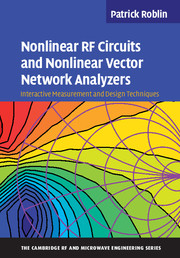 Nonlinear RF Circuits and Nonlinear Vector Network Analyzers
Nonlinear RF Circuits and Nonlinear Vector Network Analyzers Published online by Cambridge University Press: 05 July 2011
In this chapter we shall first review the various measurement techniques which are traditionally used for the characterization of RF circuits. Next we will introduce several nonlinear vector network analyzers (NVNAs) that have been developed to characterize the nonlinear response of circuits at radio frequencies (RF). Having described the operating principle of the various NVNAs, we will then focus in the rest of this chapter on the sampler-based NVNA. In particular, its operating principle, calibration, and extension to broadband modulation and pulsed RF signals will be discussed in detail. Overall, this chapter will provide some insights into nonlinear measurement techniques, which should complement the remaining chapters concerned with platform-independent modeling, design, and linearization techniques.
Measurement of RF signals
Various kinds of equipment are used to acquire and analyze RF signals: power meters, spectrum analyzers, oscilloscopes, vector signal analyzers. Power meters are used to accurately measure the RF power. Usually they are used to characterize steady-state RF signals but some power meters have a wide input bandwidth and can provide a measurement of the instantaneous signal power for modulated RF signals within a prescribed bandwidth. The accuracy of power meters is usually traceable to world standards and such equipment can therefore be used for power calibration.
Spectrum analyzers permit the measurement of the power spectral density of RF signals versus frequency. Typically the data are acquired during a finite-duration time window and Fourier transformed to the frequency domain for a wide frequency range.
To save this book to your Kindle, first ensure [email protected] is added to your Approved Personal Document E-mail List under your Personal Document Settings on the Manage Your Content and Devices page of your Amazon account. Then enter the ‘name’ part of your Kindle email address below. Find out more about saving to your Kindle.
Note you can select to save to either the @free.kindle.com or @kindle.com variations. ‘@free.kindle.com’ emails are free but can only be saved to your device when it is connected to wi-fi. ‘@kindle.com’ emails can be delivered even when you are not connected to wi-fi, but note that service fees apply.
Find out more about the Kindle Personal Document Service.
To save content items to your account, please confirm that you agree to abide by our usage policies. If this is the first time you use this feature, you will be asked to authorise Cambridge Core to connect with your account. Find out more about saving content to Dropbox.
To save content items to your account, please confirm that you agree to abide by our usage policies. If this is the first time you use this feature, you will be asked to authorise Cambridge Core to connect with your account. Find out more about saving content to Google Drive.